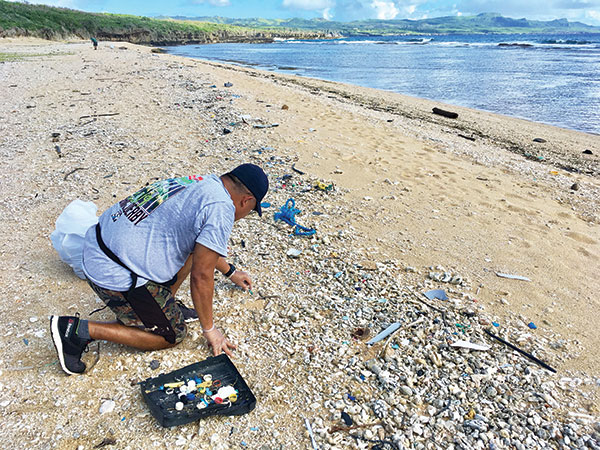Addressing the trash problem through behavioral change

Division of Environmental Quality director Ray Masga picks up trash at Tank Beach. Masga is one of the many volunteers on the island who joined the rest of the world cleanup the shores in celebration of the International Coastal Cleanup last Saturday. (Iva Maurin)
As CNMI volunteers geared up and headed down the coast to take part in the International Coastal Cleanup last Saturday, there was one type of trash they were really concerned about—plastic.
Based on the 2019 ICC report by the Ocean Conservancy, an estimated eight million metric tons of plastic waste flows into the ocean every year. This is the equivalent of one dump truck full of plastic “dumping” into the ocean every single minute of every day, polluting beaches and coastlines, and affecting 800 species of marine life.
This is crucial, especially for islands like the CNMI.
Rochelle Vasquez of Papago, one of the volunteers, believes that humans have created an environmental crisis.
“We created the environmental crisis that’s going on now, and it is important to clean up our own mess,” Vasquez said. “We should help end the environmental crisis that we have created. This cleanup is important because it has a unity aspects where people from all over the world can come together as one to help clean up the earth to make it a better place.”
At the ICC, people from all over the island came out and volunteered to clean up the shores, joining millions of people all over the world.
Division of Environmental Quality director Ray Masga, who joined the volunteers clean up at Tank Beach, heralded the volunteers for their “show of an unselfish care for the environment.”
“[The volunteers] are doing their part to unselfishly come out and take care of our environment,” Masga said. “One of the ways that we can demonstrate this is people volunteering, coming out and showing that they really do care about how the environment provides for us, home to build on, food, plant and animals to raise.”
Masga, however, quickly stressed the need for people to throw trash properly.
“There are people who just selfishly throw trash where they are not supposed to,” Masga said, quickly adding that “even though the trash [has been thrown] up on the hillside, in the jungle, or wherever, it eventually could end up on the coasts because they could get into the waterways.”
One of the key ways to address this is through environmental education campaigns all over the island, to change community behavior toward trash.
“A lot of this is just an attitude of not understanding why it is important not to just throw trash in the jungle, or to tell our kids [about proper trash management] so they would not go and take the garbage there or by the coast,” Masga said.
“We need more public education, and public education meaning, that we go in and enforce the litter regulations and cite people. Maybe that’s the hard way of learning, but eventually, people have to realize that we need to change. We need to change our behavior.”
The Bureau of Environmental and Coastal Quality and other agencies, with the Saipan Mayor’s Office, have the responsibility of making sure that no illegal dumping occurs on the island. However, it is also up to all members of the community to do their part in properly managing trash.























